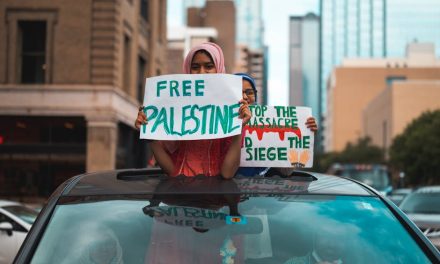Table of Contents
“Embracing the Inevitable: A Journey Towards Lasting Peace in Israel/Gaza”
Introduction
The Inevitability of Peace in Israel/Gaza
The conflict between Israel and Gaza has been a long-standing and deeply rooted issue, characterized by violence, political tensions, and territorial disputes. However, despite the seemingly endless cycle of conflict, there remains a glimmer of hope for the inevitability of peace in the region. This introduction will explore the factors that contribute to the potential for peace in Israel and Gaza, highlighting the importance of diplomacy, international pressure, and the desire for a better future among the people living in the region.
Historical Perspectives on Peace Efforts in Israel/Gaza

The conflict between Israel and Gaza has been a long-standing issue that has captured the attention of the international community for decades. Despite the seemingly endless cycle of violence and unrest, there have been numerous peace efforts made throughout history to bring about a resolution to this conflict. Understanding the historical perspectives on these peace efforts is crucial in order to grasp the potential for peace in the future.
One of the earliest peace efforts in the region can be traced back to the Oslo Accords of 1993. This agreement, brokered by the United States, aimed to establish a framework for peace negotiations between Israel and the Palestinians. It was a significant step forward as it marked the first time that the two parties officially recognized each other’s existence. However, the Oslo Accords ultimately failed to bring about a lasting peace due to a lack of trust and commitment from both sides.
Following the failure of the Oslo Accords, the international community continued to make efforts to facilitate peace negotiations. The Camp David Summit in 2000, hosted by then-US President Bill Clinton, was another significant milestone in the pursuit of peace. The summit brought together Israeli Prime Minister Ehud Barak and Palestinian Authority President Yasser Arafat in an attempt to reach a final status agreement. Despite intense negotiations, the summit ended without a resolution, leading to a renewed wave of violence known as the Second Intifada.
In 2005, Israel unilaterally withdrew its forces and settlers from the Gaza Strip, a move that was seen by many as a step towards peace. However, the subsequent rise of Hamas, an Islamist militant group, complicated the situation and led to further conflict. The 2008-2009 Gaza War and subsequent conflicts in 2012 and 2014 highlighted the challenges in achieving a lasting peace in the region.
In recent years, there have been renewed efforts to revive the peace process. The Trump administration’s “Deal of the Century” proposed a new framework for peace, which included the recognition of Jerusalem as Israel’s capital and the establishment of a Palestinian state. While this plan was met with mixed reactions, it demonstrated the ongoing commitment of the international community to finding a solution.
Despite the setbacks and failures of past peace efforts, there are reasons to remain hopeful for a peaceful resolution in the future. The changing dynamics in the region, including the normalization of relations between Israel and several Arab states, have created new opportunities for dialogue and cooperation. Additionally, the younger generation in both Israel and Gaza, who have grown up in a climate of conflict, are increasingly advocating for peace and a two-state solution.
In conclusion, the historical perspectives on peace efforts in Israel and Gaza provide valuable insights into the challenges and opportunities for achieving a lasting resolution. While past attempts have been met with limited success, the changing dynamics in the region and the growing desire for peace among the younger generation offer hope for a brighter future. It is essential for the international community to continue supporting and facilitating dialogue between the parties involved, as only through sustained efforts can the inevitability of peace in Israel and Gaza be realized.
The Role of International Diplomacy in Achieving Peace in Israel/Gaza
The conflict between Israel and Gaza has been a long-standing issue that has caused immense suffering and loss of life on both sides. However, despite the seemingly endless cycle of violence, there is hope for a peaceful resolution through the intervention of international diplomacy.
International diplomacy plays a crucial role in achieving peace in Israel and Gaza. It provides a platform for dialogue and negotiation between the conflicting parties, allowing them to address their grievances and find common ground. Through diplomatic channels, countries can exert pressure on both Israel and Gaza to engage in peaceful negotiations and work towards a lasting solution.
One of the key ways in which international diplomacy can facilitate peace is through mediation. Mediators act as neutral third parties, facilitating communication and negotiation between the conflicting parties. They help to bridge the gap between Israel and Gaza, encouraging them to find common ground and compromise on their differences. Mediation can be a lengthy and complex process, but it has proven successful in resolving conflicts in other parts of the world.
Another important aspect of international diplomacy is the role of international organizations. Organizations such as the United Nations (UN) and the European Union (EU) have been actively involved in promoting peace in Israel and Gaza. They provide a platform for dialogue, facilitate negotiations, and offer support to the conflicting parties. The UN, in particular, has played a significant role in peacekeeping efforts and has deployed peacekeeping forces to the region to maintain stability and prevent further escalation of violence.
Furthermore, international diplomacy can also help address the underlying causes of the conflict. Issues such as land disputes, access to resources, and the status of Jerusalem are deeply rooted and require long-term solutions. Through diplomatic efforts, countries can work towards addressing these underlying issues and finding mutually acceptable solutions. This may involve compromises and concessions from both Israel and Gaza, but it is essential for a sustainable peace agreement.
However, it is important to acknowledge that achieving peace in Israel and Gaza is a complex and challenging task. The conflict is deeply entrenched, with deep-seated historical, religious, and political factors at play. The conflicting parties have deep-rooted grievances and mistrust, making it difficult to find common ground. Additionally, there are external factors such as regional dynamics and the influence of other countries that further complicate the situation.
Despite these challenges, international diplomacy remains a crucial tool in achieving peace in Israel and Gaza. It provides a platform for dialogue, mediation, and negotiation, allowing the conflicting parties to address their grievances and work towards a mutually acceptable solution. While progress may be slow and setbacks are inevitable, the international community must continue to support diplomatic efforts and encourage both Israel and Gaza to engage in meaningful dialogue.
In conclusion, the role of international diplomacy in achieving peace in Israel and Gaza cannot be overstated. Through mediation, the involvement of international organizations, and addressing underlying causes, diplomatic efforts can help bridge the gap between the conflicting parties. While the road to peace may be long and challenging, it is essential to continue supporting diplomatic initiatives and working towards a lasting solution. Only through sustained international diplomacy can the inevitability of peace in Israel and Gaza be realized.
Economic Factors and Peace Prospects in Israel/Gaza
The Israeli-Palestinian conflict has been a long-standing issue that has plagued the region for decades. However, despite the seemingly insurmountable challenges, there are several economic factors that suggest the inevitability of peace in Israel and Gaza.
One of the key economic factors that contribute to the prospects of peace is the mutual benefit of economic cooperation. Both Israel and Gaza have much to gain from a peaceful resolution to the conflict. Israel, as a technologically advanced nation, can provide expertise and investment opportunities to help develop Gaza’s economy. On the other hand, Gaza’s strategic location and access to natural resources can be beneficial for Israel’s economic growth. By working together, both parties can create a mutually beneficial economic relationship that would incentivize peace.
Another economic factor that supports the prospects of peace is the potential for increased trade and economic integration. Currently, the Israeli blockade on Gaza severely restricts the movement of goods and people, stifling economic growth in the region. However, if peace is achieved, trade barriers can be lifted, allowing for the free flow of goods and services between Israel and Gaza. This would not only boost economic growth but also foster a sense of interdependence, making it harder for either party to resort to violence.
Furthermore, the potential for economic development in Gaza can help address some of the underlying causes of the conflict. High unemployment rates and poverty have been major drivers of unrest in the region. By investing in infrastructure, education, and job creation, the international community can help alleviate these socio-economic issues, providing a more stable foundation for peace. Economic development can also create a sense of hope and optimism among the population, reducing the appeal of extremist ideologies and violence.
Additionally, economic factors can play a crucial role in building trust and confidence between the parties involved. Economic cooperation requires a certain level of trust and interdependence, which can help break down barriers and foster dialogue. Joint economic projects, such as shared industrial zones or cross-border investments, can create opportunities for Israelis and Palestinians to interact and collaborate, building personal relationships that can transcend political differences.
Moreover, economic factors can also influence the political dynamics within Israel and Gaza. Economic growth and prosperity can strengthen moderate voices within both societies, making it harder for extremist factions to gain support. As people’s livelihoods improve, they become more invested in maintaining peace and stability, creating a positive feedback loop that reinforces the prospects of peace.
In conclusion, while the Israeli-Palestinian conflict has been a source of immense suffering and division, there are several economic factors that suggest the inevitability of peace in Israel and Gaza. The mutual benefits of economic cooperation, the potential for increased trade and economic integration, the role of economic development in addressing underlying causes of the conflict, the building of trust and confidence, and the influence on political dynamics all contribute to the prospects of peace. By recognizing and harnessing these economic factors, the international community can play a crucial role in facilitating a peaceful resolution to the conflict.
The Importance of Grassroots Movements in Promoting Peace in Israel/Gaza
The Israel-Gaza conflict has been a long-standing issue that has caused immense suffering and loss of life on both sides. However, amidst the chaos and violence, there is a glimmer of hope in the form of grassroots movements that are working tirelessly to promote peace and reconciliation in the region. These movements, driven by ordinary citizens who are tired of the cycle of violence, are playing a crucial role in bringing about a lasting peace in Israel and Gaza.
One of the key reasons why grassroots movements are so important in promoting peace is their ability to bridge the divide between communities. In a conflict as deeply entrenched as the Israel-Gaza conflict, there is a significant lack of trust and understanding between Israelis and Palestinians. Grassroots movements, by bringing people from both sides together, provide a platform for dialogue and empathy. Through face-to-face interactions, individuals are able to humanize the “other” and challenge the stereotypes and prejudices that have fueled the conflict for decades.
Moreover, grassroots movements have the advantage of being able to operate outside the constraints of political agendas. While politicians often prioritize their own interests and the interests of their respective governments, grassroots movements are driven solely by the desire for peace. This allows them to focus on finding common ground and building bridges, rather than getting caught up in the political rhetoric and power struggles that have hindered progress in the past.
Another crucial aspect of grassroots movements is their ability to mobilize and engage the wider community. By organizing events, protests, and awareness campaigns, these movements are able to raise public consciousness about the need for peace. They provide a platform for individuals who may not have been directly affected by the conflict to voice their support for peace and demand change. This collective pressure can have a significant impact on policymakers and create a conducive environment for peace negotiations.
Furthermore, grassroots movements often work at the grassroots level, addressing the root causes of the conflict. They focus on issues such as education, economic development, and social justice, which are essential for building a sustainable peace. By investing in education and promoting cross-cultural understanding, these movements are laying the foundation for a future generation that is more tolerant and open-minded. By addressing economic disparities and promoting inclusive development, they are addressing some of the underlying grievances that have fueled the conflict.
While grassroots movements are undoubtedly making a difference, it is important to acknowledge the challenges they face. The Israel-Gaza conflict is deeply complex and deeply rooted, and achieving peace will require a multifaceted approach. Grassroots movements alone cannot solve all the problems, but they play a crucial role in creating the conditions necessary for a lasting peace.
In conclusion, grassroots movements are of utmost importance in promoting peace in Israel and Gaza. Their ability to bridge divides, operate outside political agendas, mobilize communities, and address root causes of the conflict make them a powerful force for change. While the road to peace may be long and arduous, these movements provide hope and inspiration for a future where Israelis and Palestinians can coexist in harmony. It is through their tireless efforts that the inevitability of peace in Israel and Gaza becomes a reality.
Q&A
1. Is peace between Israel and Gaza inevitable?
No, peace between Israel and Gaza is not inevitable.
2. What are the main obstacles to achieving peace in Israel/Gaza?
The main obstacles to achieving peace in Israel/Gaza include territorial disputes, security concerns, political divisions, and differing ideological and religious beliefs.
3. Have there been any significant efforts towards peace in the region?
Yes, there have been several significant efforts towards peace in the region, including peace agreements such as the Oslo Accords and the Abraham Accords, as well as numerous international mediation efforts.
4. What factors could potentially contribute to the achievement of peace in Israel/Gaza?
Factors that could potentially contribute to the achievement of peace in Israel/Gaza include mutual recognition, trust-building measures, diplomatic negotiations, economic development, and international support and involvement.
Conclusion
In conclusion, the achievement of peace in Israel and Gaza is a complex and challenging process. However, it is not impossible. With sincere efforts, political will, and international support, the inevitability of peace in the region can be realized. It requires a commitment to dialogue, compromise, and addressing the root causes of the conflict. Ultimately, a peaceful resolution is crucial for the well-being and prosperity of both Israelis and Palestinians, and for the stability of the entire region.




